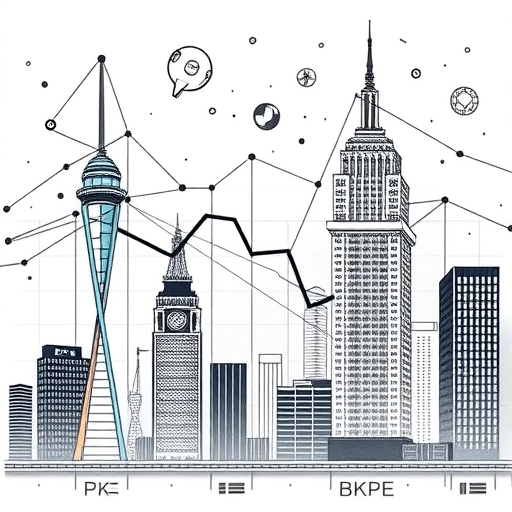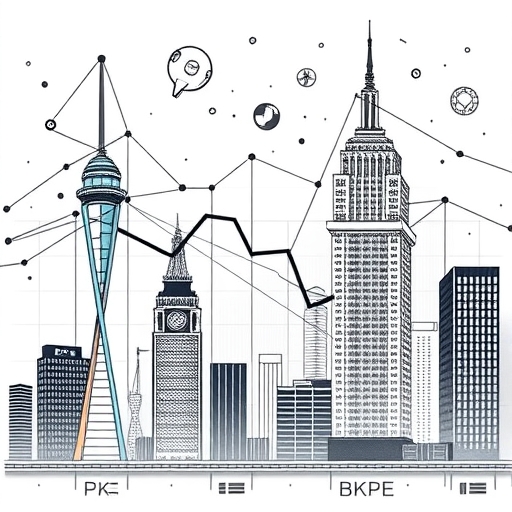Navigating the Financial Labyrinth: How Corporate Resilience, Policy Shifts, and Economic Realities are Shaping Markets
In the dynamic landscape of global finance, understanding the intricate dance between macroeconomic forces and market movements is paramount for any investor, whether you’re taking your first steps or refining advanced trading strategies. We are currently observing a complex interplay where U.S. stocks rally with unexpected vigor, even as bond yields slide, signaling deeper shifts in economic expectations. This confluence of events is heavily influenced by the actions and anticipated moves of the Federal Reserve, creating a challenging yet potentially rewarding environment for those who grasp its nuances.
- The connection between corporate earnings and market movements is becoming increasingly apparent.
- Understanding fiscal policies and their ramifications is essential for informed investing.
- Anticipating the Federal Reserve’s actions can help investors navigate volatile markets.
Consider the past few months: we’ve witnessed significant rallies in major indices like the S&P 500, reaching all-time highs and demonstrating remarkable recovery. Yet, beneath this buoyant surface, concerns over fiscal stability and the impact of evolving trade policies linger. How do these seemingly contradictory signals fit together? How do corporate earnings, trade wars, and central bank decisions truly shape the investment climate you operate within? Let’s embark on a journey to decode these forces, offering you the clarity needed to navigate this complex financial world.

In this illustration, we see a visual representation of financial market dynamics that encapsulates the intricate relationships at play.
Here is a summary of some key factors influencing current market trends:
| Factor | Impact |
|---|---|
| Corporate Earnings | Higher earnings lead to stock rallies, bolstering investor confidence. |
| Trade Policies | Protectionist measures create winners and losers in various sectors. |
| Federal Reserve Actions | Rate cuts can encourage borrowing and spending, impacting stocks and bonds. |
Unpacking the S&P 500’s Ascent: Earnings as the Primary Catalyst
Have you felt the exhilaration of watching market indices climb higher, perhaps even setting new records? Much of the recent uplift in U.S. equity markets, particularly the S&P 500, has been a direct consequence of stronger-than-expected corporate earnings reports. Companies across various sectors have defied some of the broader economic headwinds, delivering profits that surpassed analyst estimates. This underlying fundamental strength often serves as the most potent catalyst for stock market advancement, reflecting the health and adaptability of individual businesses.
For instance, on a specific day in April, we saw the S&P 500 surge by 2.8%, the Dow Jones Industrial Average by a similar margin, and the Nasdaq Composite by an impressive 3.3%. This collective upward movement was buoyed by positive results from diverse entities. Companies like Equifax and 3M reported robust performance, signaling resilience within their respective industries. Even within the housing sector, PulteGroup‘s strong profit reports underscored a surprising vigor, benefiting from specific shifts in bond markets that led to lower mortgage rates, stimulating demand for new homes.
Furthermore, consumer-facing giants such as Home Depot (HD.N) and Kimberly-Clark, despite facing some cost pressures, managed to present solid earnings, contributing to overall market optimism. These individual company successes paint a picture of corporate America finding ways to adapt and even thrive amidst a challenging global economic backdrop. However, it’s crucial to remember that a rally fueled by earnings can be highly sensitive to future guidance and external shocks, which we will explore further.

This artwork illustrates corporate resilience in the face of economic challenges, highlighting the strength of businesses navigating uncertainties.
The Double-Edged Sword of Tariffs: Corporate Winners and Losers Unveiled
While some companies celebrate robust earnings, others grapple with the profound and often unpredictable consequences of shifting trade policies. The resurgence of protectionist measures, particularly the implementation of tariffs by previous administrations, has created a distinct cleavage in corporate performance. These policies, intended to protect domestic industries, often act as a double-edged sword, creating both unexpected winners and significant losers within the global supply chain.
Consider the solar industry: while many companies have faced increased costs due to broader tariffs, First Solar, for instance, has strategically benefited from solar-specific tariffs imposed on imports from Southeast Asian nations. These tariffs created a more favorable competitive landscape for domestic manufacturers, leading to increased demand and profitability for companies like First Solar. This highlights how certain industries or companies, either by design or by fortunate positioning, can capitalize on protectionist measures.
| Company | Impact of Tariffs |
|---|---|
| First Solar | Gained market advantage due to solar tariffs. |
| RTX | Faced increased costs due to reliance on global supply chains. |
| Kimberly-Clark | Reported profit impacts directly related to tariffs. |
Conversely, many other corporations have faced substantial headwinds. RTX, a major aerospace and defense company, and consumer products giant Kimberly-Clark both issued warnings about increased costs and profit hits directly attributable to tariffs. These companies, reliant on global supply chains for raw materials and components, found their input costs rising dramatically, directly impacting their bottom line and forcing difficult decisions regarding pricing and production. The ongoing uncertainty surrounding these trade policies and the potential expiration of retaliatory tariffs only add layers of complexity, making long-term strategic planning a formidable challenge for businesses.
Beyond the Headlines: Deconstructing Market Volatility and Investor Sentiment
Despite impressive earnings reports, the market’s journey is rarely a smooth ascent. Even after a series of gains, we frequently observe sudden pullbacks, underscoring the inherent market volatility and the fickle nature of investor sentiment. For example, the S&P 500, after a six-day streak of gains, eventually snapped its positive run, with major indexes easing. What drives these abrupt shifts, and how can you, as an investor, interpret them?
Often, these shifts are not solely about corporate performance but rather about broader macroeconomic and fiscal concerns. Worries about the expanding U.S. budget deficit, especially in light of proposed tax cuts, can trigger anxieties among investors regarding national debt and future economic stability. When a major credit rating agency like Moody’s Investors Service downgrades the U.S. credit rating, it serves as a stark reminder of these underlying fiscal pressures, fanning concerns and impacting confidence. These top-down factors can quickly overshadow positive individual company news, leading to a broader market decline.
The Fed’s Rate Conundrum: Anticipating Cuts Amidst Softening Economic Signals
One of the most powerful forces shaping current market dynamics is the evolving stance of the Federal Reserve. Their monetary policy decisions, particularly regarding interest rates, send ripple effects across every asset class. Currently, the dominant narrative revolves around the anticipation of future rate cuts. Why are traders and investors so focused on this, and what signals are the Fed considering?
Signs of softening U.S. economic data have been accumulating, prompting market participants to increasingly factor in the likelihood of the Fed reducing borrowing costs. A weakening labor market, for instance, if not indicative of a full recession, certainly suggests a cooling economy that might benefit from monetary easing. Traders are now largely anticipating at least two 25-basis-point rate cuts from the Fed by the end of 2025. This expectation is a significant driver of bond market behavior, as lower interest rates generally lead to higher bond prices and lower yields.
However, the Fed’s decisions are not made in a vacuum. They must balance the need to support economic growth with the persistent challenge of managing inflation. As we will discuss, inflation remains above their target, creating a delicate balancing act for policymakers. Any cautious remarks from Fed officials, or data that deviates from the expected path, can quickly alter these expectations, causing swift market adjustments. This constant vigilance over Fed commentary and economic indicators is essential for understanding the potential trajectory of both interest rates and the broader economy.
Yield Dynamics: From U.S. Treasury Slides to Japanese Surges
The bond market, often seen as a more sober and measured counterpoint to the volatile stock market, provides critical signals about economic health and interest rate expectations. We’ve recently observed fascinating and somewhat contrasting movements in bond yields across the globe. In the U.S., Treasury yields have shown a tendency to slide, reaching their lowest levels of the year, while in Japan, super-long government bond yields have surged to all-time highs. What does this tell us?
In the U.S., the slide in 10-year Treasury yields, which eased to around 4.29% at one point from higher levels, is directly linked to the aforementioned expectations of impending Fed rate cuts. Lower yields imply cheaper borrowing costs, not just for the government but also for consumers, particularly impacting mortgage rates. This softening in yields suggests that the market believes the U.S. economy requires stimulus, making borrowing more affordable to spur activity. However, these yields can also inch higher again due to fiscal concerns, as demonstrated when longer-dated U.S. Treasury yields, like the 10-year at 4.477% and the 30-year at 4.965%, rose in response to worries about the U.S. budget deficit. This tug-of-war between monetary easing expectations and fiscal concerns defines the current U.S. bond market.

This concept image illustrates the interconnectedness of financial markets, emphasizing how one market’s movement can influence another.
Across the Pacific, the situation in Japan offers a stark contrast. Japanese super-long government bond yields soaring to all-time highs due to poor auctions indicate a different set of market dynamics. This surge points to nervousness about the Japanese government’s fiscal health and potentially a shift in expectations for the Bank of Japan’s ultra-loose monetary policy. The divergence between U.S. and Japanese bond markets highlights the localized economic conditions and policy frameworks that can lead to vastly different yield trajectories, offering opportunities for those engaged in global macro trading strategies.
The Dollar’s Dance and Gold’s Gleam: Monetary Policy Ripple Effects
Monetary policy decisions by central banks, particularly the Federal Reserve, exert significant influence not only on domestic markets but also on global currency and commodity markets. The U.S. dollar, as the world’s reserve currency, is particularly sensitive to these shifts, and its movements often have a direct impact on other asset classes, including safe-haven commodities like gold.
We’ve observed the dollar stabilize and even decline at various points, partly attributed to cautious remarks from Fed officials. When the Fed signals a more dovish stance, or when economic data suggests a weakening U.S. economy that might necessitate rate cuts, the dollar tends to weaken against other major currencies. A weaker dollar makes U.S. exports more competitive but also makes imports more expensive, potentially feeding into domestic inflation. Conversely, a stronger dollar can dampen inflation by making imports cheaper.
This dollar depreciation has a symbiotic relationship with gold prices. As the dollar weakens, gold, priced in dollars, becomes relatively cheaper for holders of other currencies, thereby increasing demand. Furthermore, in times of economic uncertainty or when conventional assets like stocks and bonds appear volatile, gold’s traditional role as a safe-haven asset is reinforced. Its rally indicates a flight to safety, where investors seek to preserve capital in the face of perceived risks. The persistence of inflation, with the PCE index at 2.3% (still above the Fed’s 2% target), also contributes to gold’s appeal, as it is often seen as a hedge against rising prices and the erosion of purchasing power.
For those interested in capitalizing on these currency movements and commodity trends, understanding the broader macro environment is key. If you’re considering expanding your trading horizons into the foreign exchange market or exploring other Contracts for Difference (CFD) products, then Moneta Markets is a platform worth considering. Hailing from Australia, it boasts over 1000 financial instruments, catering to both novice and professional traders alike, providing a robust environment to engage with these dynamic markets.
Navigating the Geopolitical Maze: Trade Wars, Tariffs, and Global Uncertainty
Beyond the realm of corporate earnings and central bank machinations, geopolitical factors and trade policies inject another layer of complexity into financial markets. The “trade war” initiated by President Trump, characterized by the imposition of tariffs and threats against various countries, has profoundly impacted investor sentiment and global supply chains. These policies introduce significant uncertainty, causing sharp “jerks up and down” in equity markets as investors react to every development.
The direct impact of these policies on international trade relationships is undeniable. Ongoing negotiations with countries like India, Canada, Mexico, and particularly China, create a fluid environment where the terms of trade can shift rapidly. The expiration of retaliatory tariffs in July, for instance, could either alleviate or exacerbate existing pressures, depending on the outcome of diplomatic efforts. This constant state of flux makes long-term investment planning challenging, as the regulatory and cost environment for multinational corporations remains unpredictable.
Moreover, geopolitical tensions, such as the Israel-Iran war, while not directly tied to trade tariffs, contribute to an overarching atmosphere of global uncertainty. Such conflicts can disrupt energy markets, impact commodity prices, and influence investor confidence in a broader sense. While President Trump’s focus was predominantly on trade, his open criticism of the Fed Chair also contributed to market anxiety, blurring the lines between economic policy and political intervention. For investors, this means maintaining a keen awareness of both economic indicators and the ever-shifting geopolitical landscape, as the latter can swiftly dictate market direction and risk appetite.
The Supply Chain Strain: How Tariffs Reshape Corporate Strategy and Consumer Prices
Tariffs are not merely lines on a policy document; they have tangible, far-reaching consequences that ripple through global supply chains, affecting corporate bottom lines and ultimately influencing consumer prices. When a tariff is imposed on imported goods or components, businesses face a choice: absorb the increased cost, find alternative (often more expensive) suppliers, or pass the cost onto the consumer. Each choice has significant implications for profitability, competitive positioning, and inflation.
For companies like RTX and Kimberly-Clark, the experience has been one of increased costs, directly translating to reduced profit margins or the need to raise prices. This is a common narrative for industries heavily reliant on international trade for their raw materials or manufacturing processes. These pressures compel companies to rethink their supply chain strategies, potentially leading to reshoring of production or diversification of suppliers, processes that are both costly and time-consuming.
From a broader economic perspective, tariffs are expected to mean greater costs across global supply chains, which are then likely to be passed through to consumers, contributing to higher inflation statistics. This consumer price pass-through, especially when coupled with persistent inflation trends (like the PCE index remaining above target), adds pressure on households and can dampen consumer confidence. Thus, tariffs are not just a trade policy tool but a significant inflationary factor and a catalyst for corporate strategic shifts, underscoring their profound impact on the real economy.
Unpacking Fiscal Pressures: Debt, Deficit, and Credit Rating Concerns
Beyond the immediate market gyrations driven by earnings and central bank signals, a more structural concern looms large for the U.S. economy: its fiscal health. Discussions around the burgeoning U.S. budget deficit and the national debt burden have intensified, particularly in the context of proposed tax cuts. These fiscal realities directly influence investor confidence and can have a material impact on long-term investment decisions, particularly concerning government bonds.
The proposal for sweeping U.S. tax cuts, while potentially stimulating short-term economic activity, also raises concerns about accelerating the budget deficit. A larger deficit means the government must borrow more, potentially increasing the supply of Treasury bonds and putting upward pressure on yields. When a prominent institution like Moody’s Investors Service downgrades the U.S. credit rating, it sends a powerful signal to global investors. Such a downgrade, while not immediately catastrophic, serves to fan concerns about the nation’s increasing debt load and its ability to manage its finances responsibly in the long run. It suggests an elevated risk profile for lending to the U.S. government, which can influence interest rates and the dollar’s strength over time.
For investors, these fiscal concerns translate into a need for greater scrutiny of government spending and taxation policies. The long-term implications of rising national debt on economic growth, inflation, and the government’s capacity to respond to future crises are significant. Understanding these underlying fiscal pressures is crucial for forming a holistic view of the U.S. economic outlook and its attractiveness for both domestic and international capital.
The Global Economic Canvas: IMF Forecasts and Recessionary Whispers
Our journey through the current financial landscape would be incomplete without casting our gaze globally. The U.S. economy, despite its size, does not operate in a vacuum. Broader global economic trends and forecasts significantly influence investor sentiment, commodity prices, and corporate performance. Recently, international bodies have painted a more subdued picture of global growth, raising questions about the sustainability of current market rallies.
The International Monetary Fund (IMF), a leading voice in global economic assessment, recently slashed its global economic growth forecast for 2025 to 2.8% from an earlier 3.3%. This revision signals a cautious outlook, reflecting a slowdown in major economies, persistent inflation in many regions, and ongoing geopolitical tensions. Such a downward revision by a respected institution like the IMF serves as a reality check, reminding investors that while the U.S. may show pockets of strength, the global backdrop is one of tempered expectations.
Moreover, these macroeconomic forecasts often come with “recessionary whispers”—concerns that a prolonged period of high inflation, aggressive monetary tightening by central banks, or persistent trade frictions could tip major economies into a downturn. While a full-blown recession may not be imminent, the mere possibility influences corporate investment decisions, consumer confidence, and overall market risk appetite. Understanding these global macro signals is essential for any investor. It helps you assess the broader context in which individual companies and national economies are operating, allowing for more informed and resilient investment strategies.
Charting Your Course: Navigating the Interconnected Financial World
The financial markets of today present a tapestry woven with threads of corporate strength, nuanced monetary policy, unpredictable trade relations, and overarching fiscal concerns. We’ve seen how robust corporate earnings can propel stocks rally, pushing indices to new highs, yet this vigor is constantly tested by the chilling effect of tariffs and the specter of global economic slowdown. Simultaneously, the strategic dance of the Federal Reserve, navigating persistent inflation and softening economic data, directly influences the trajectory of bond yields slide, impacting everything from mortgage rates to the strength of the U.S. dollar.
As you reflect on these intricate connections, remember that successful navigation hinges on a holistic understanding. No single factor dictates market direction; rather, it is the complex interplay of all these forces—how a policy decision in Washington can ripple through a company’s supply chain, how an inflation reading impacts the Fed’s next move, and how global growth forecasts temper investor enthusiasm. Your ability to connect these dots, to see the big picture while also understanding the granular details, will be your greatest asset.
The journey ahead promises continued volatility and uncertainty, but also significant opportunities for those who are well-informed and adaptable. Whether you’re tracking the minute-by-minute fluctuations of the S&P 500 or analyzing long-term trends in Treasury yields, staying abreast of these interconnected dynamics is paramount. As we continue to provide you with insights, we encourage you to use this knowledge not just to react to market movements but to anticipate them, allowing you to master your investment journey and realize your financial goals.
If you’re delving deeper into the mechanics of financial markets and considering various trading instruments, selecting a platform that aligns with your needs is critical. Moneta Markets offers a comprehensive suite of tools, supporting mainstream platforms like MT4, MT5, and Pro Trader. Coupled with high-speed execution and competitive low spreads, it aims to provide a superior trading experience for engaging with the complexities we’ve discussed, from currency pairs to indices and commodities.
FAQ
Q:What are the primary factors driving stock market rallies?
A:Strong corporate earnings, favorable economic data, and anticipation of Federal Reserve actions contribute significantly to stock market rallies.
Q:How do tariffs affect corporate performance?
A:Tariffs can create winners and losers by increasing costs for some companies while providing competitive advantages to others in protected industries.
Q:What role does the Federal Reserve play in shaping market expectations?
A:The Federal Reserve influences interest rates and economic conditions through its monetary policy decisions, affecting both stock and bond markets.
